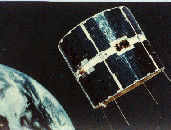|
The COS-B Satellite
The ESA mission COS-B, along with NASA’s SAS-2,
provided the first detailed views of the Universe in Gamma-rays. COS-B carried a single
large experiment, the Gamma-Ray Telescope, which was responsibility of a
group of European research laboratories know as the
Caravane Collaboration. Launched on the 9 August 1975, COS-B was
originally projected to last two years, but it operated successfully for 6
years and 8 months. It provided the first complete map of the Galaxy in
gamma-rays.
Mission Characteristics
Page authors: Lorella Angelini Jesse Allen HEASARC Home | Observatories | Archive | Calibration | Software | Tools | Students/Teachers/Public Last modified: Thursday, 24-Sep-2020 18:30:39 EDT HEASARC Staff Scientist Position - Applications are now being accepted for a Staff Scientist with significant experience and interest in the technical aspects of astrophysics research, to work in the High Energy Astrophysics Science Archive Research Center (HEASARC) at NASA Goddard Space Flight Center (GSFC) in Greenbelt, MD. Refer to the AAS Job register for full details. |


